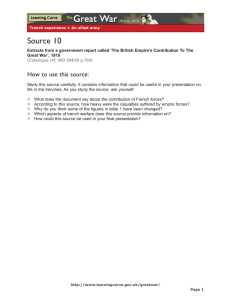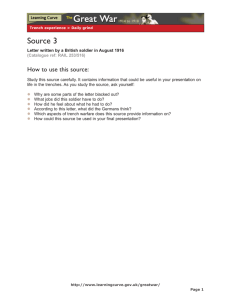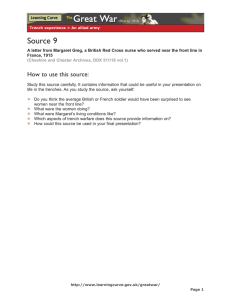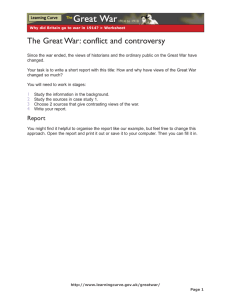Immediate Cause of World War I
advertisement
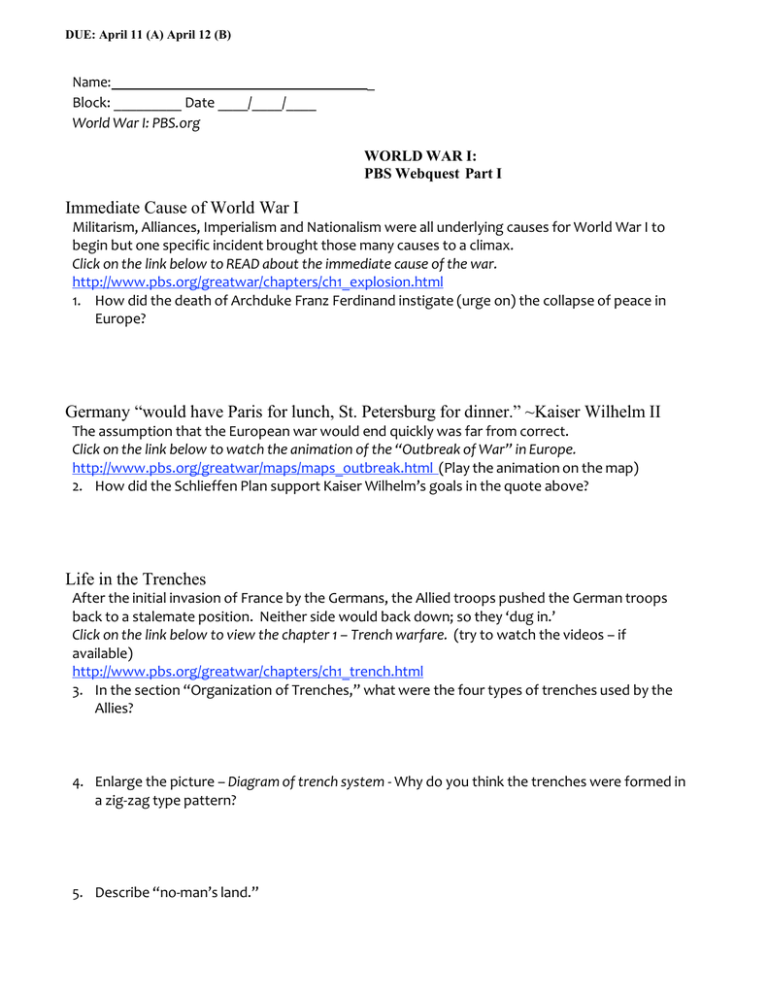
DUE: April 11 (A) April 12 (B) Name: Block: _________ Date ____/____/____ World War I: PBS.org _ WORLD WAR I: PBS Webquest Part I Immediate Cause of World War I Militarism, Alliances, Imperialism and Nationalism were all underlying causes for World War I to begin but one specific incident brought those many causes to a climax. Click on the link below to READ about the immediate cause of the war. http://www.pbs.org/greatwar/chapters/ch1_explosion.html 1. How did the death of Archduke Franz Ferdinand instigate (urge on) the collapse of peace in Europe? Germany “would have Paris for lunch, St. Petersburg for dinner.” ~Kaiser Wilhelm II The assumption that the European war would end quickly was far from correct. Click on the link below to watch the animation of the “Outbreak of War” in Europe. http://www.pbs.org/greatwar/maps/maps_outbreak.html (Play the animation on the map) 2. How did the Schlieffen Plan support Kaiser Wilhelm’s goals in the quote above? Life in the Trenches After the initial invasion of France by the Germans, the Allied troops pushed the German troops back to a stalemate position. Neither side would back down; so they ‘dug in.’ Click on the link below to view the chapter 1 – Trench warfare. (try to watch the videos – if available) http://www.pbs.org/greatwar/chapters/ch1_trench.html 3. In the section “Organization of Trenches,” what were the four types of trenches used by the Allies? 4. Enlarge the picture – Diagram of trench system ‐ Why do you think the trenches were formed in a zig‐zag type pattern? 5. Describe “no‐man’s land.” Total War By 1915, the war had become a global war. Click on the link below and read about how the war had become global. http://www.pbs.org/greatwar/chapters/ch2_war.html 6. Name 3 ways that the war had become a global war – as opposed to simply a ground war fought in Europe. Slaughter The battles on the Western front are known for their huge number of losses sustained by the Allied troops. Click on the link below to read about the battles. http://www.pbs.org/greatwar/chapters/ch2_slaughter.html 7. How many soldiers were lost at the Battle of Somme, Verdun & Ypres? WORLD WAR I: PBS Webquest Part II Mutiny In 1917, after years of combat, trench warfare and the disruption of daily lives in European nations, many countries wanted to continue fighting to victory. However, as time passed and the nations rejected all peace initiatives, people on both sides began to question the manslaughter and violence. Click on the link below to read about the disillusionment and disobedience of soldiers on the front lines. http://www.pbs.org/greatwar/chapters/ch3_mutiny.html 8. How did mutinies (or rebellions) affect the French and Russian army? Read the section labeled ‐ The End of Heroism – on the right side of the Mutiny page. 9. Explain how the soldiers living in the trenches ‘lived with the dead.’ Collapse Despite the sinking of the Lusitania in May 1915, President Woodrow Wilson was able to negotiate trade with belligerents of the war without provoking Germany. Click on the link below to read about how America got involved in World War I. http://www.pbs.org/greatwar/historian/hist_kennedy_01_wilson.html 10. What led to the American involvement in the Great War? By 1918, 5 million American soldiers were in uniform and helping the Allied forces end the Great War. Click on the link to read about how the war ended http://www.pbs.org/greatwar/chapters/ch3_collapse.html 11. Describe what events led to the collapse of the German army/navy and their war effort. How did the Kaiser’s abdication (giving up) of the throne affect the war effort? Hatred & Hunger On the 11th day of the 11th month, the Allies and Central Powers agreed to an armistice or cease‐ fire. People all over the globe experienced feelings of nationalism, self‐determination and the opportunities of democracy but many knew the peace was not likely to last. Click to read about the peace agreement and treatment of Germany following the armistice. http://www.pbs.org/greatwar/chapters/ch4_hatred.html 12. Though the armistice was in effect, how did the Allies still wage war on Germany? 13. When Woodrow Wilson arrived in Paris in 1918, what was the one thing he wanted from the peace negotiations? Look at the photograph above “Hatred & Hunger” 14. Who were the Big Four at the peace conference? War Without End Once the war ended, many military men were very attached to their experiences of war. They had experienced camaraderie like never before. Click on the link below to read about how people were affected by the war. http://www.pbs.org/greatwar/chapters/ch4_war.html 15. How did Germans feel differently than other Europeans about the war? Look at the map of Europe 1918‐1920. 16. How many new countries were created by the Treaty of Versailles? Compare this map to the map of Europe in 1914. http://www.pbs.org/greatwar/maps/index.html DUE: April 11 (A) April 12 (B) Politics in the 1920s Warren G. Harding and Calvin Coolidge were not the most dynamic speakers, progressive reformers or exciting presidents. However, they were safe and conservative and they lulled the American public into a sense of security and “normalcy” (Harding’s made-up word, not mine). And “normal’, for American history, means economic problems and presidential scandals – just look at the Harding administration. First, look back at the “Election of 1920”. (1) Why was Harding elected? (3) Describe Harding’s Cabinet “Best Minds” (4) How did the “’New’ Old Guard” improve on laissez-faire? (5) How did Harding’s Supreme Court feel about progressive reform? How do you know? The Teapot Dome Scandal (6) What is “teapot dome”? (7) What was the scandal and who was involved? (8) What happened to the people involved in the Teapot Dome scandal? (9) Which other scandals erupted during Harding’s presidency? (10) How was Harding spared dealing with the worst of the scandals? “Worst Minds” Coolidge becomes President (11) What was one of Coolidge’s nicknames? _________________________ (12) According to your text, Coolidge became “the ________________ of the great god Business”. What does that mean? (13) Election of 1924 Democrats Republicans Progressivism Candidate Platform Votes Received & supporting region (see map) And the winner is (drumroll, please) __________________________________! Effects of World War I on Domestic and Foreign Affairs Fill in the chart below with SPECIFIC EXAMPLES from the reading. The Results of War Domestic Railroad Regulation Esch-Cummins Transportation Act Labor Unions & Strikes Race Relations Veterans Groups Veteran’s Bureau American Legion Adjusted Compensation Act: Shipping Regulation Merchant Marine Act of 1920 Farmer’s Problems How did peace affect the price of crops? Why? Changes in Foreign Policy How did new inventions affect the farmer? Capper-Volstead Act: McNary-Haugen Bill: Sum up the 1920s for farmers in one word: _____________________ (1) How long did the US remain officially “at war” with the Central Powers? ____________ How and when did the US finally achieve legal peace? ______________________________________________________ (2) “_____________ was enthroned in Washington”. What does that mean? (3) What was the agenda of the Washington Conference? a. b. (4) What was Secretary Hughes plan for disarmament? (5) Identify the following: a. Five-Power naval treaty b. four power treaty c. nine-power treaty (6) What was the Kellog-Briand Pact? What did it do and how successful was it? Tariffs, Again (7) What was the Fordney Mc-Cumber Tariff Law? What did it do? (8) Items upon which the tariffs were increased (9) How did the high tariffs affect the rest of the world? Items upon which the tariffs were decreased The Roaring 20’s “The Solemn Referendum” 1. Why was the election of 1920 called the “solemn referendum”? Who called it that? 2. The Election of 1920 Democrats Republicans Candidates (president & VP) Platform Supporters And the winner is: _____________________________________________!! Red Scare & Labor Strife 3. What were Americans afraid of in the early 1920s? 4. Americans think that ____________ are caused by Communists. 5. What happened in Seattle in 1919? What was the result? 6. Who was A. Mitchell Palmer? What did he do? 7. Define “criminal syndicalism laws”. 8. How did anti-union employers use the red scare to their advantage? 9. Who were Sacco and Vanzetti? What were they accused of doing? KKK Resurges 10. When did the KKK resurface? 11. What was their new agenda? How was the Klan of 1920 different from the Klan of 1860? 12. How was the Klan’s bubble “burst”? Immigration & Reaction 13. Problem: Too Many Immigrants from: _____________________ Quota System (define): 1921: 1924: Prohibition & Gangsters 14. What did the 18th Amendment say? 15. How did American feel about prohibition? Midwest & South Returning Soldiers Feelings Immigrants Why? 16. Define the following terms a. Prohibition b. “noble experiment” c. Homebrew d. Speakeasies 17. How did prohibition lead to an increase in crime? 18. Briefly describe Al Capone & his connection to prohibition. 19. Religious Fundamentalism vs Modernism What was John Dewey’s “revolutionary contribution” to American education? 20. What are Fundamentalists? How did they try to stop the “moral breakdown” of youth? Working Class 21. Identify the main figures in “The Monkey Trial”. a. John T. Scopes b. Clarence Darrow c. William Jennings Bryan 22. Who won in the clash between theology & biology? 23. For each of the headings below, jot down important names, dates and facts. A. Mass-Consumption Economy B. Cars & Planes How did the Automobile create social change? C. Radio, Film & other Entertainment What are “Flappers” The Lost Generation: Literature of Alienation 24. How was the New Generation of writers different from the previous generation of American authors? 25. Important American authors to know – identify their works & brief meaning/style/message of the writing a. F. Scott Fitzgerald b. Ernest Hemingway c. William Faulkner d. Eugene O’Neill You should also know about Gertrude Stein & Zelda Fitzgerald – but for some reason, your text makes no mention of them. I wonder why? Economy 26. How were people in the 1920s riding high on the “economic joyride”? (Give examples of ways to make money) 27. What was the job of the Bureau of the Budget? 28. Who is Mellon? What did he believe about taxes and what happened as result?

